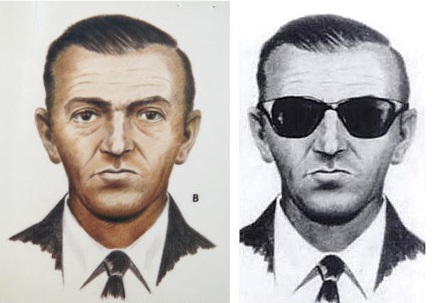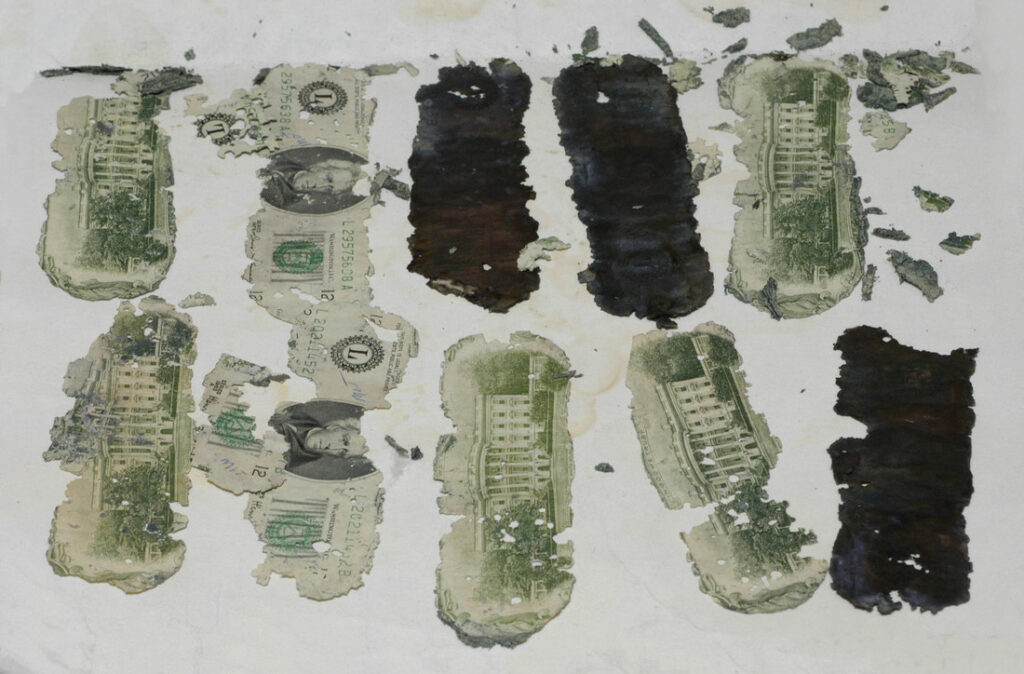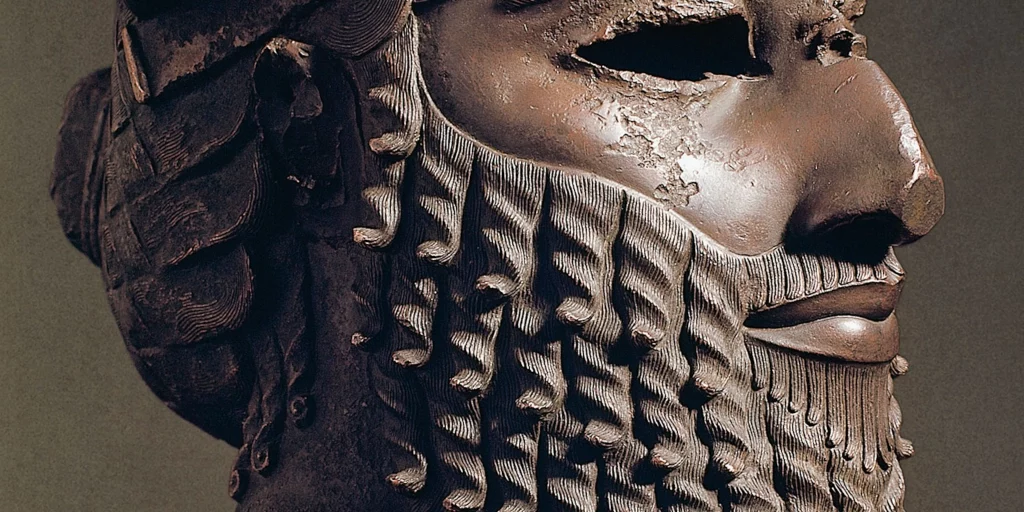The mysterious figure of D.B. Cooper and the perplexing case that surrounds him have fascinated and baffled both investigators and the public for decades.
It all began on the night of November 24, 1971. An individual who would later be famously dubbed “D.B. Cooper” boarded a Boeing 727 bound for Seattle, Washington, departing from Portland, Oregon.
What followed was a heist involving a $200,000 ransom, a daring parachute jump, and a mystery that has endured for over half a century.

Background and Hijacking
On that fateful Thanksgiving eve, Northwest Orient Flight 305 took off from Portland International Airport in Oregon, bound for Seattle. Little did the 43 passengers and crew know that their journey would soon take an unexpected and terrifying turn.
Somewhere over the rugged terrains of Washington state, the man who would be called D.B. Cooper handed a note to one of the flight attendants. The flight attendant opened the note and read it:
“Miss – I have a bomb in my briefcase and want you to sit by me.”
The hijacker initially told the flight attendant that his name was “Dan Cooper.” But due to a reporter’s error, his name was mistakenly recorded as “D. B. Cooper,” and the rest is history.
The flight attendant sat with him as he dictated his demands to her. The flight attendant relayed the message to the cockpit, and the gravity of the situation began to sink in. Cooper had succeeded in hijacking the aircraft without raising any alarm amongs the passengers.
In the cockpit, the pilot relayed the demands to air traffic control. Cooper’s demands were specific. He wanted the pilot to land the plane at Seattle-Tacoma International Airport.
This is what he expected to be waiting for him: $200,000 in cash, four parachutes, and a fuel truck standing by to refuel the plane for his getaway.
The Ransom and Second Flight
When the plane landed in Seattle, Cooper remained onboard with the crew and passengers. The passengers still had no idea what was taking place.
The plane was refueled. Once a courier delivered the money and the parachutes, Cooper released the 36 passengers but kept the crew. What Cooper did not know is that the FBI had carefully cataloged the serial numbers of each of the 10,000 bills.
By 7:40 PM Flight 305 was back in the air headed for Mexico City, Mexico with another refueling stop planned in Reno. During the flight, Cooper ordered the crew to fly the plane at a low altitude, slow speed, and with the landing gear down.
The crew complied and then retreated to the cockpit to avoid being sucked out of the plane when Cooper opened the aft staircase. This was the last time the crew saw Cooper.
Somewhere over the dense wilderness of southern Washington, a warning light flashed. This indicated that the aft staircase had been deployed.
Upon the plane’s landing in Reno for refueling, both local law enforcement and the FBI conducted a thorough search. But D.B. Cooper was not onboard. It was assumed he had deployed his parachute and was hiding somewhere in the Washington wilderness.
Investigation and Suspects
Search teams combed the wilderness in the vicinity of Cooper’s presumed jump location for weeks. No conclusive evidence of his whereabouts was discovered. It seemed he had vanished without a trace.
A month following the hijacking, the FBI sent out lists of the ransom serial numbers to financial institutions, casinos, racetracks, and global law enforcement agencies in hopes of tracking Cooper down.
But by 1973, the ransom money still remained unaccounted for. If Cooper didn’t spend the money, where was it?
The FBI has examined countless potential suspects and persons of interest over the years in connection with the D.B. Cooper case but to no avail. To this day, the crime remains the only unsolved case of air piracy in the United States.
Theories and Potential Whereabouts
The enduring mystery of D.B. Cooper’s fate has fascinated true-crime enthusiasts and given rise to a myriad of theories and speculations.
Survival in the Wilderness: Some believe that D.B. Cooper successfully parachuted into the rugged wilderness of Washington and managed to survive. Proponents of this theory argue that he was skilled in outdoor survival but there is no evidence to say he was or he wasn’t.
Reintegration into Society: In the years following the hijacking, stories emerged of a mysterious individual in the local area who matched Cooper’s description. Some believe that he may have integrated into a nearby community, becoming a kind of local legend.
Death in the Wilderness: On the other end of the spectrum, there are theories suggesting that Cooper did not survive his parachute jump and instead perished in the harsh wilderness. The vast and challenging terrain could have proved insurmountable.
Miscalculations: Because no one witnessed Cooper jump from the plane it is possible that he was never able to deploy the parachute. He could have become disoriented by the darkness making it difficult to pull the ripcord.
Evidence Emerges
Nearly ten years after Cooper’s daring escape no evidence of the money or any new suspects ever emerged. But in early 1980, an eight-year-old boy who was vacationing on the Columbia River with his family, made a fateful discovery.
As he was searching near the river bank he came across three packets of badly deteriorated money in bundles and bound with rubber bands. In total, there was $5,800 dollars in moldy, muddy, bills.
FBI forensics experts tested the bills and confirmed the bills matched the serial numbers of the ransom money. Finally, authorities had evidence of Cooper but it only created more questions than it answered.

Popular Culture and Legacy
The D.B. Cooper case has remained one of the most mysterious cases in the history of American crime. The legend of D.B. Cooper has maintained a steadfast hold on the public’s fascination and has been a wellspring of inspiration for both movies and television.
The hijacking also prompted a reevaluation of security measures in the airline industry. New protocols and regulations were put in place to prevent similar hijackings from happening, including:
Improved Cockpit Security: It may seem like common sense today, but before Cooper’s hijacking, cockpit doors did not have a locking mechanism. One of the most significant changes was the introduction of reinforced cockpit doors. These doors are designed to prevent unauthorized access to the flight deck. This makes it much more difficult for hijackers to gain control of the aircraft.
Enhanced Passenger Screening: In 1971 most airports did not use metal detectors. The hijacking of Northwest Orient Flight 305, and other hijackings during that era, played a significant role in prompting the aviation industry to enhance security screening measures before boarding.
Crew Training: Flight crews received training to deal with hijacking situations, with an emphasis on communication and cooperation to thwart hijackers. They were taught how to handle and defuse hijacking attempts, and their role in ensuring passenger safety became even more critical.
Cooperation with Law Enforcement: Improved coordination and communication between airlines, airports, and law enforcement agencies became a priority. Airlines worked closely with authorities to respond to and manage hijacking incidents more effectively.
Rapid Response Teams: Some airlines formed specialized security teams that could respond rapidly to hijacking threats or other security incidents. These teams were trained to assess and mitigate threats, working in tandem with law enforcement agencies.
No More Skyjacking: A spree of hijackings in the late 1960s and early 1970s, including D.B. Cooper’s, led to the aviation industry adopting a zero-tolerance policy for hijackings. This policy meant that airlines would no longer negotiate with hijackers, reducing the likelihood of future hijackings.
Background Checks and Passenger Screening: Airports and airlines began implementing more comprehensive background checks on employees and passengers. This included checking passengers against watchlists and improving the vetting process for airline employees.
Recent Developments
In 2016, the FBI decided to conclude its investigation into the D.B. Cooper case, reassigning its resources to other priorities. Importantly, the Bureau retained the existing evidence related to the case.
However, a significant piece of potential evidence remained elusive: D.B. Cooper’s cigarette butts from the flight, which could have held valuable DNA information, were nowhere to be found.
Even though the official investigation was closed, it hasn’t stopped members of the public from continuing to follow leads and explore the mystery.
In 2020, an amateur scientist made an intriguing discovery. Microscopic traces of algae, known as “diatoms,” were found on the money that had been unearthed in 1980. What made this finding significant was that the diatoms observed on these bills indicated a springtime bloo. This suggests that the money had only been in contact with water during one season.
This finding refuted one of the earlier theories, which had suggested that the money went into the water at the time of Cooper’s parachute jump in November 1971.
Conclusion
In the world of true crime, the D.B. Cooper case has become an iconic symbol of the uncatchable criminal. It is a mystery that has sparked countless investigations, theories, and speculations.
As the years have turned into decades, the possibility of solving the D.B. Cooper case remains an ever elusive goal. The passage of time, the limited evidence, and the many false leads have all contributed to the enduring mystery.
Whether the case is ever solved or not, the legend of D.B. Cooper will continue to captivate, challenge, and inspire generations to come.
References
D.B. Cooper Hijacking
https://www.fbi.gov/history/famous-cases/db-cooper-hijacking
D.B. Cooper
https://www.biography.com/crime-figure/db-cooper
D.B. Cooper
https://en.wikipedia.org/wiki/D._B._Cooper#Physical_evidence

